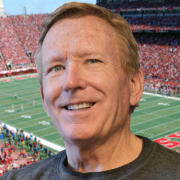Home Improvement: Memorial Stadium Through the Years

Second in a series marking the 100th season of Nebraska football in Memorial Stadium. |
|---|
You don't get to be a century old by letting yourself go.
After a mostly sleepy first 40 years, it's been one project and then another for Nebraska football's Memorial Stadium. Upward and outward it has grown to accommodate tens of thousands more fans.
Sometimes Nebraska wasn't quite keeping up with the Joneses, and other times Nebraska was the Joneses. The stadium's first press-box replacement came after it was long overdue. But Nebraska was ahead of the curve with its first video replay boards and its FieldTurf playing surface.
Somewhere along the line, the stadium became a stadium complex, and it encompassed an ever-growing list of functions. Neurological research, anyone?
The timeline below shows the march toward bigger and better. Most of the information was compiled by Nebraska Athletics, but we've added a few items, corrected a few numbers and provided bits of historical detail here and there. Scroll down past the Athletic Department time-lapse illustration, and happy time-traveling.
50 Days 🏟️#GBR pic.twitter.com/qJtwd0UQmG
— Nebraska Football (@HuskerFootball) July 12, 2023
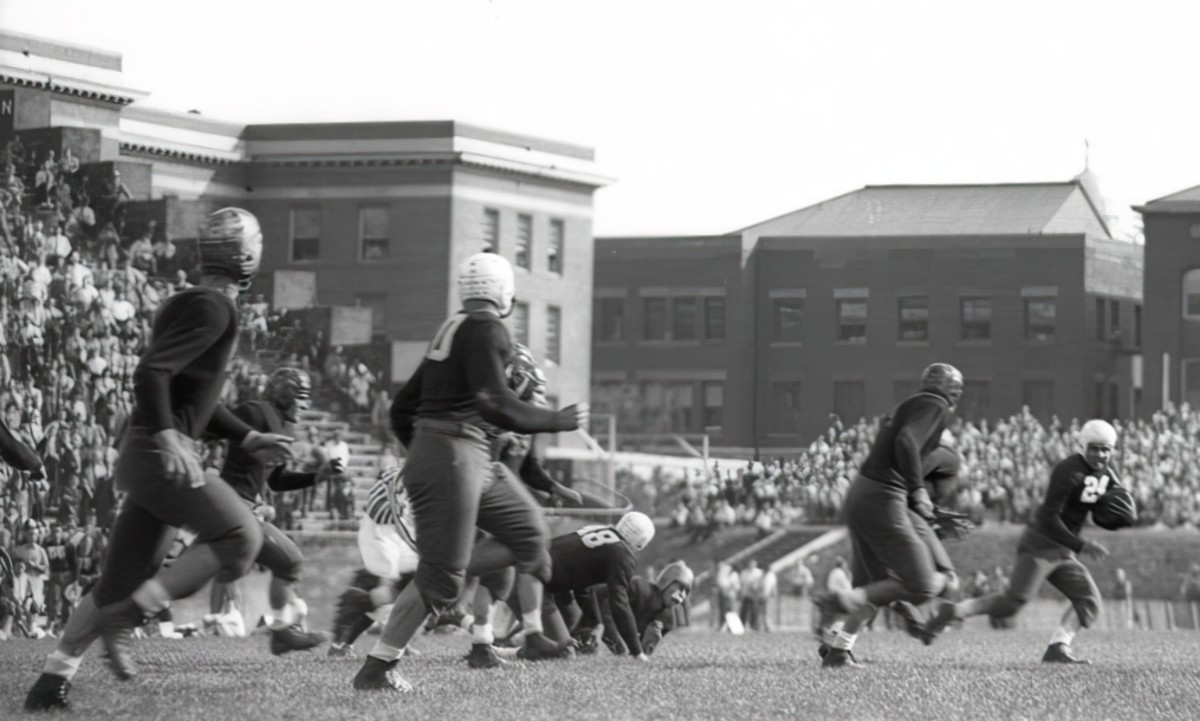
1923: Construction of the 31,000-seat stadium begins in late April, and the first game is played Oct. 13. Four decades would pass before capacity was increased with anything other than end-zone bleachers. That meant campus buildings long served as a prominent backdrop, as seen in the photo above from the late 1930s.
1939: Excavation work begins for a field house behind the north end zone, helped by funding from the Depression-era Works Progress Administration. The facility will provide lockers, showers and indoor practice space.
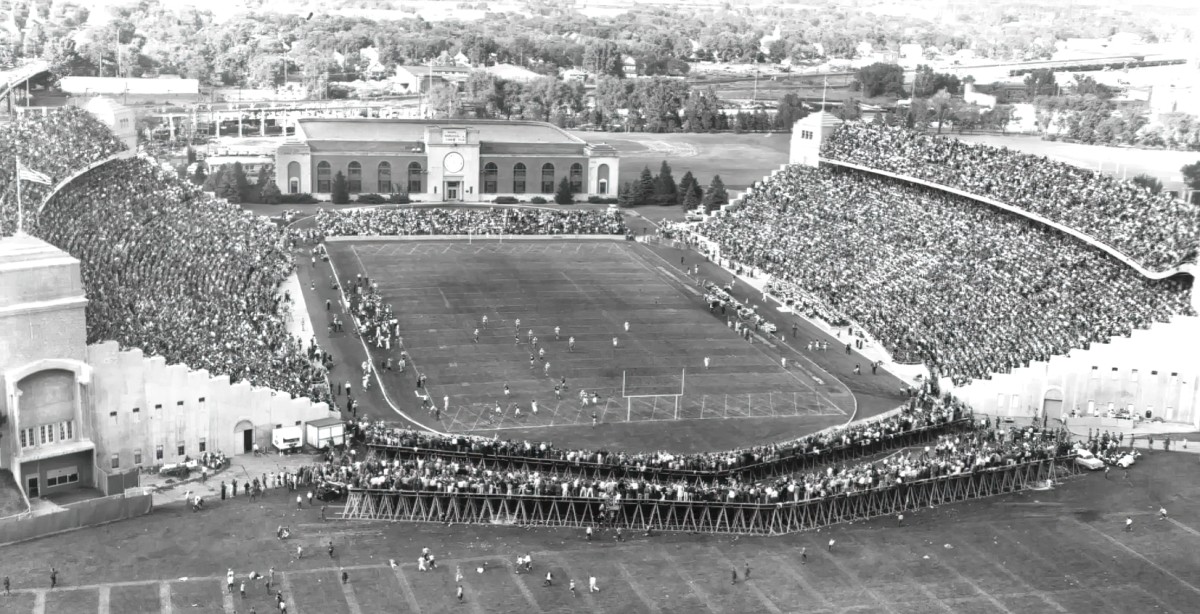
1942: Though hampered by wartime shortages, construction of the field house gets far enough along to allow the use of its locker rooms.
1949: An additional level is built atop the press box to accommodate the first television broadcasts of Husker games. Also, the field house is finally completed, and it is named in memory of coach Henry F. Schulte.
1962: In Bob Devaney's first year as the Huskers' head coach, demand for more seats starts to become evident as the streak of consecutive Memorial Stadium sellouts begins with the Missouri game on Nov. 3.
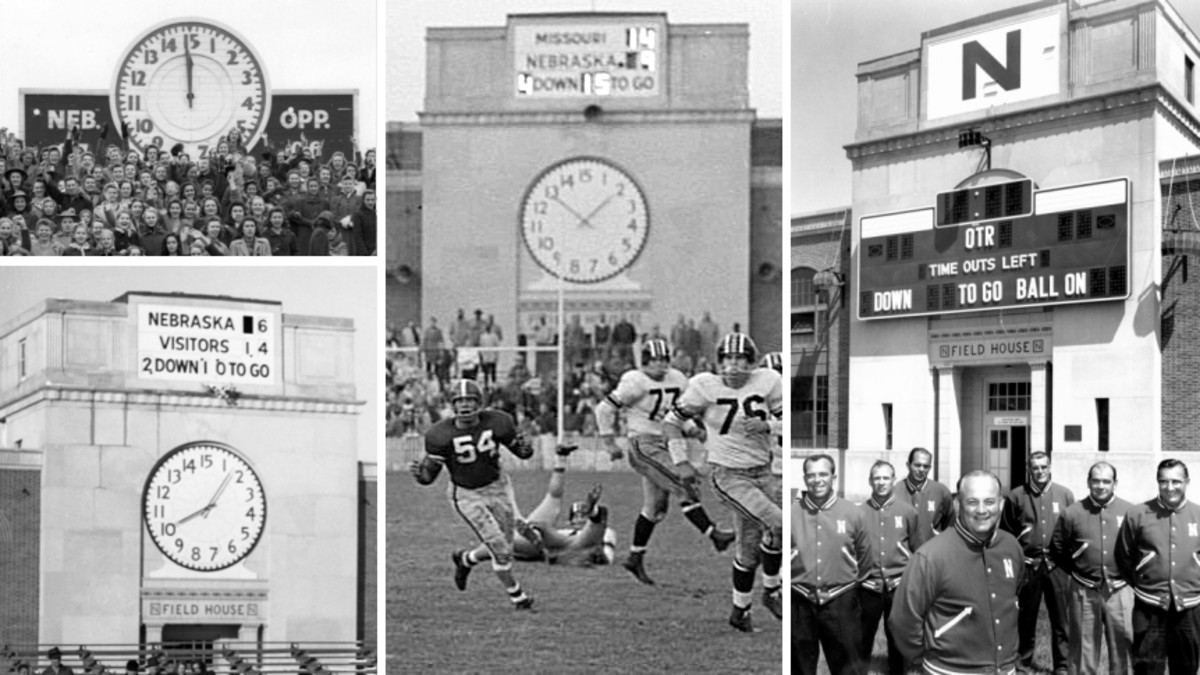
1963: A digital-style combination scoreboard and game clock replaces the sweeping-hands clock and scoreboard on the front of the field house. The photos above from 1941, 1947, 1956 and 1964 show the progression of technology, starting with the stand-alone scoreboard/clock that was positioned behind the north bleachers before the field house was built.
1964: The south end zone section is installed, making the stadium a horseshoe and boosting capacity to 44,829.
1965: The center portion of the north end zone section is built, raising capacity to 50,807. With the field house now blocked from view, the stadium's northeast and northwest towers become the new home for scoreboards.
1966: The left and right wings of the north end zone are added, raising capacity to 62,644 and making Memorial Stadium a bowl. (See construction photo at top of page.) In just three years, capacity has doubled.
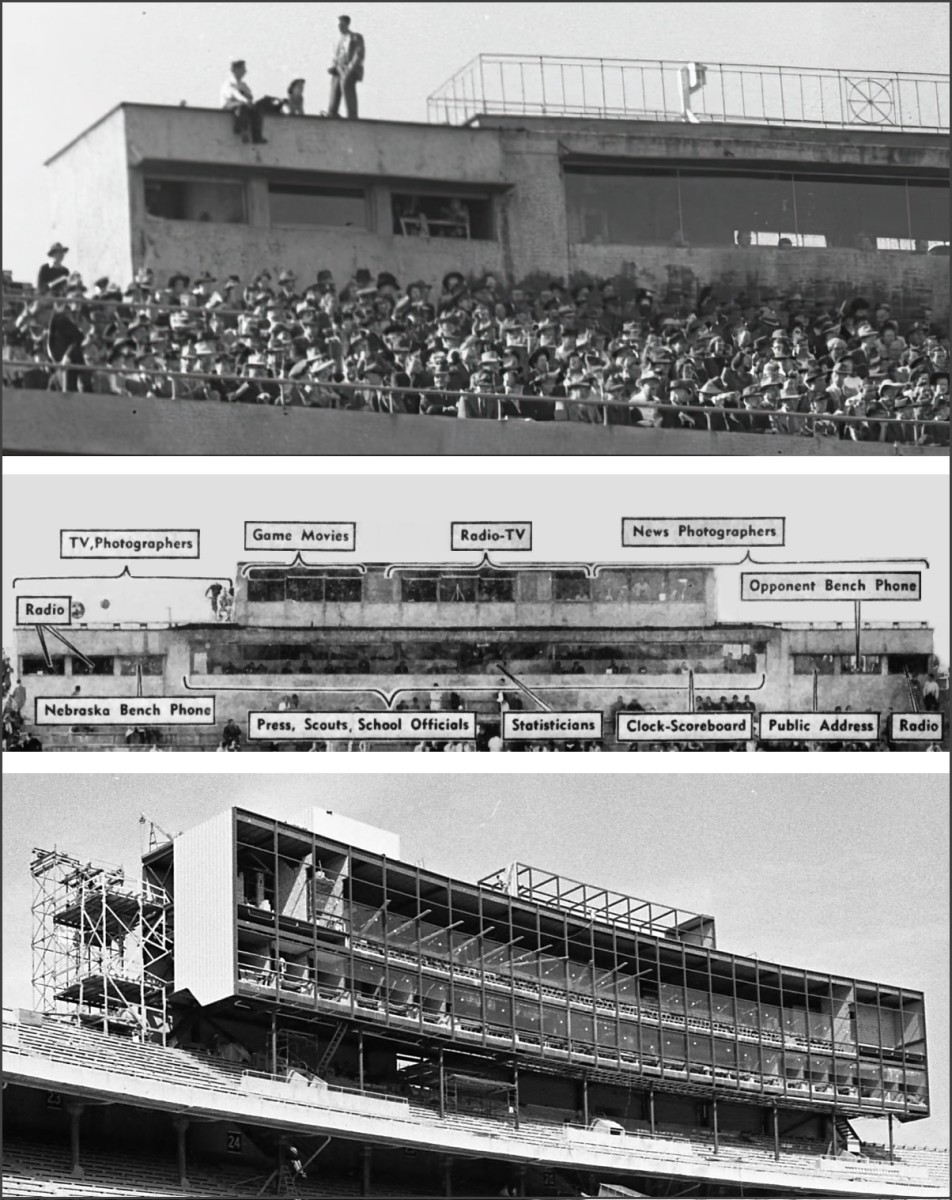
1967: A massive new press box is added, along with elevators that allow reporters to avoid a 170-stair climb to the top of West Stadium. The $500,000 project is financed in part by selling boosters 10 years of access to VIP seating in the enclosure. (With those seats, stadium capacity rises to 64,170.)
Football writers rated the original press box as one of the worst in major-college football by the end of its run in 1966. ("That old shoebox" was how radio man Lyell Bremser described it.) It is shown in 1942 and 1962 in the two upper photos.
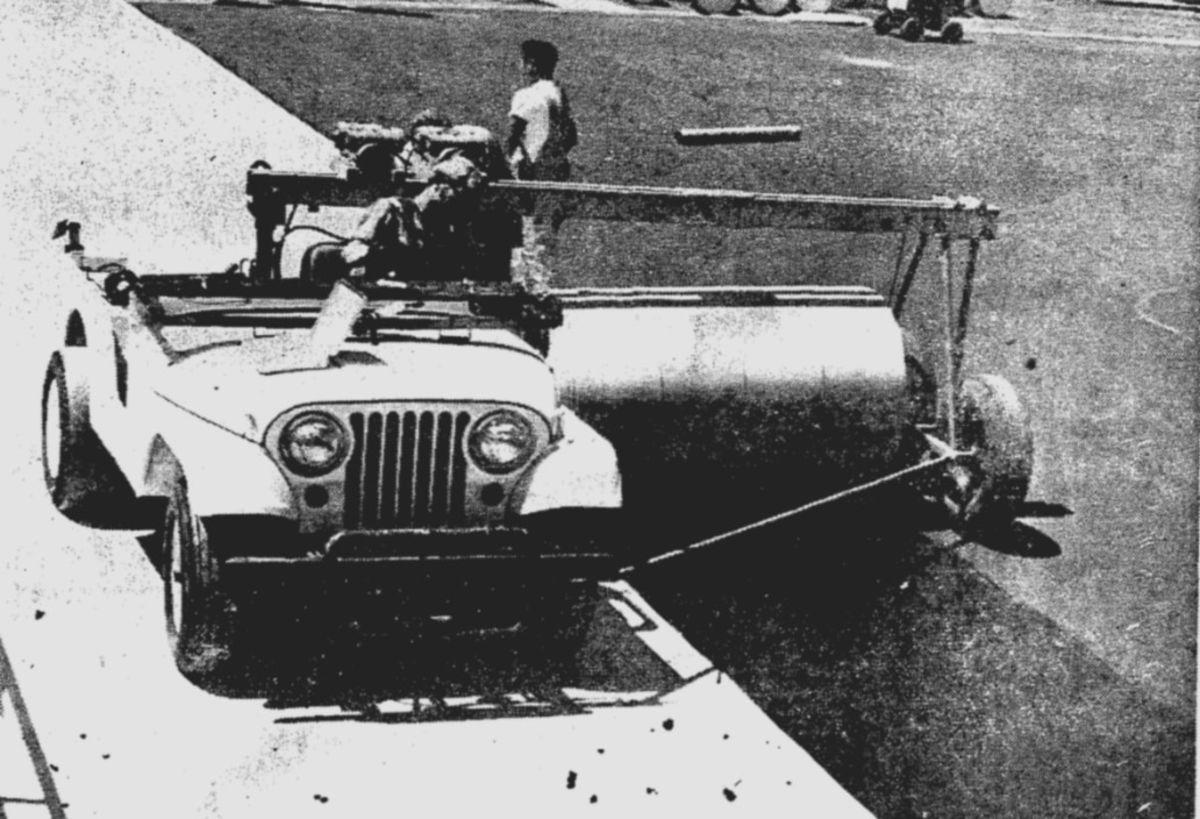
1970: AstroTurf replaces the natural grass playing field. In the photo above, ⅝-inch padding made of synthetic rubber and vinyl is laid down atop the asphalt base for the "mod sod."
1972: The south end zone is extended by roughly 9,400 seats, raising capacity to 73,650.
1973: The athletic office building beneath the south end zone seating is completed. It also contains dressing and training facilities for varsity football.
1977: New AstroTurf replaces the 1970 turf, and a new scoreboard is installed atop the north end zone section.
1980: The press box gets an upper deck for additional photo and visiting radio/TV space.
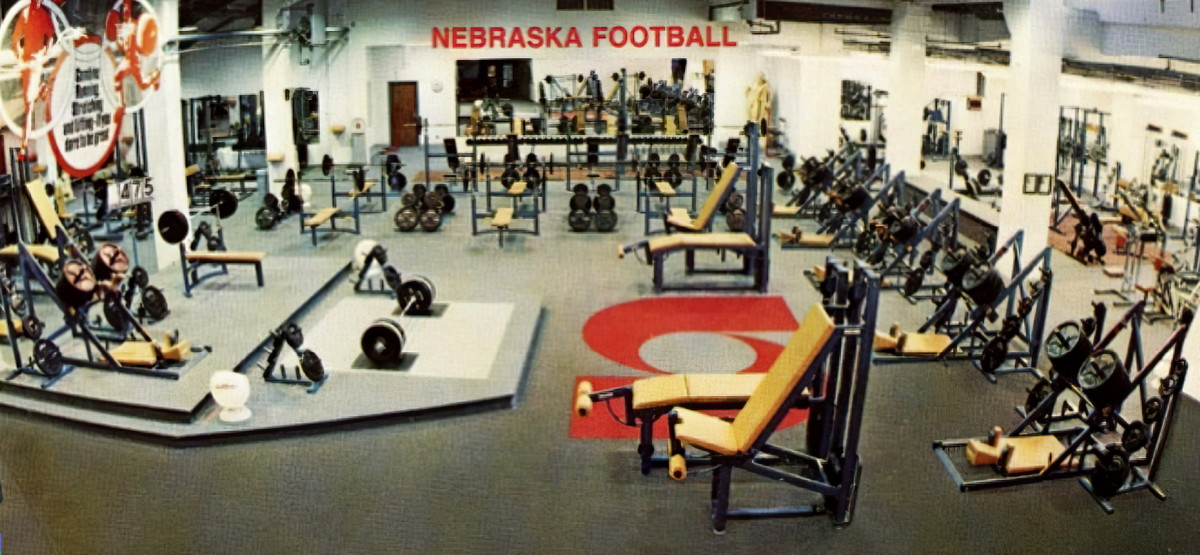
1981: A strength complex is installed in West Stadium, and the Schulte Field House gets a new visitors' locker room.
1982: The field house's indoor practice area is expanded.
1984: Artificial All-Pro Turf replaces the 1977 AstroTurf.
1985: The Hewit Center dining area/study hall is completed in West Stadium.
1989: The strength complex and Hewit Center are expanded.
1992: Astroturf-8 artificial turf replaces the 1984 All-Pro Turf.
1993: A seating section in the south end zone collapses on a Monday morning in May. The incident leads to repairs in various parts of the stadium, and annual stadium inspections by engineers are established.
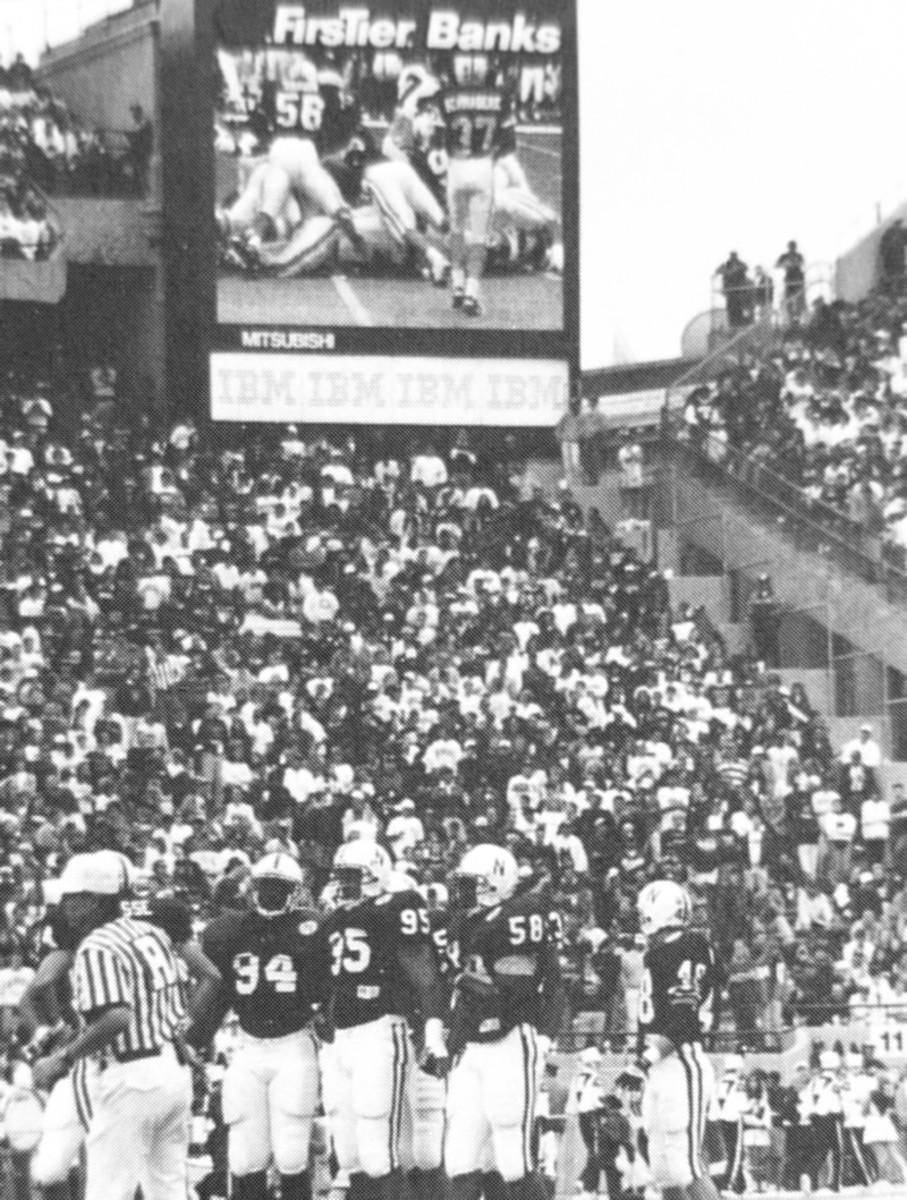
1994: Memorial Stadium becomes the nation's first college-only football stadium to get instant-replay video boards. The HuskerVision production studio is completed in West Stadium. Section 14 in South Stadium is remodeled to accommodate the disabled, reducing seating capacity to 72,700.
1995: The South Stadium training room is remodeled, and a new interview room and player lounge are completed.
1997: A two-year, $36 million stadium improvement project begins. The east concourse gets new restrooms and concessions, and stadium lights are installed on the east side.
1998: The stadium is rededicated on April 24, and the football field is named in honor of Hall of Fame Coach Tom Osborne. Lights are installed on the west side.
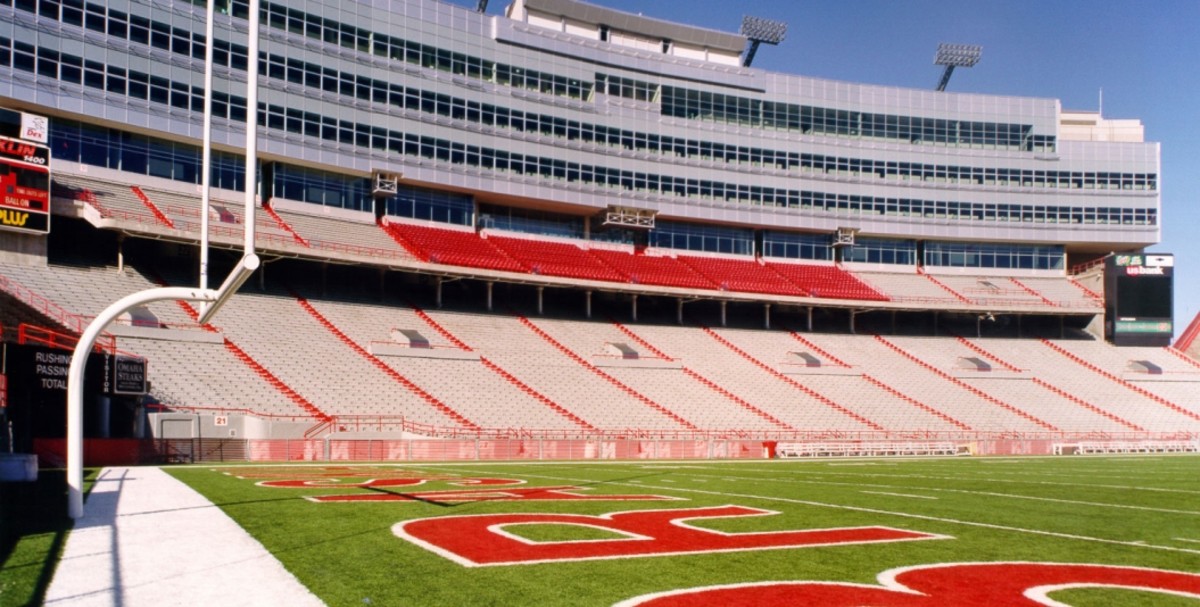
1999: The stadium improvement project is completed, including 42 skyboxes, a club seating area, a stadium view lounge, a new press box, and renovated concourses, concessions and restrooms. Seating capacity is raised to 74,056. FieldTurf is installed, making Nebraska the first Division I program to use the synthetic playing surface.
2000: Increased club seating reduces seating capacity to 73,918.
2001: The team meeting room and players' lounge near the locker room in lower South Stadium are expanded, as are the HuskerVision studio and the Hewit Center study area in West Stadium.
2004: Additional lockers are installed in the South locker room to house the entire football team during construction of the Osborne Athletic Complex on the north end of the stadium. The Schulte Field House is torn down.
2005: The 1999 FieldTurf is replaced.
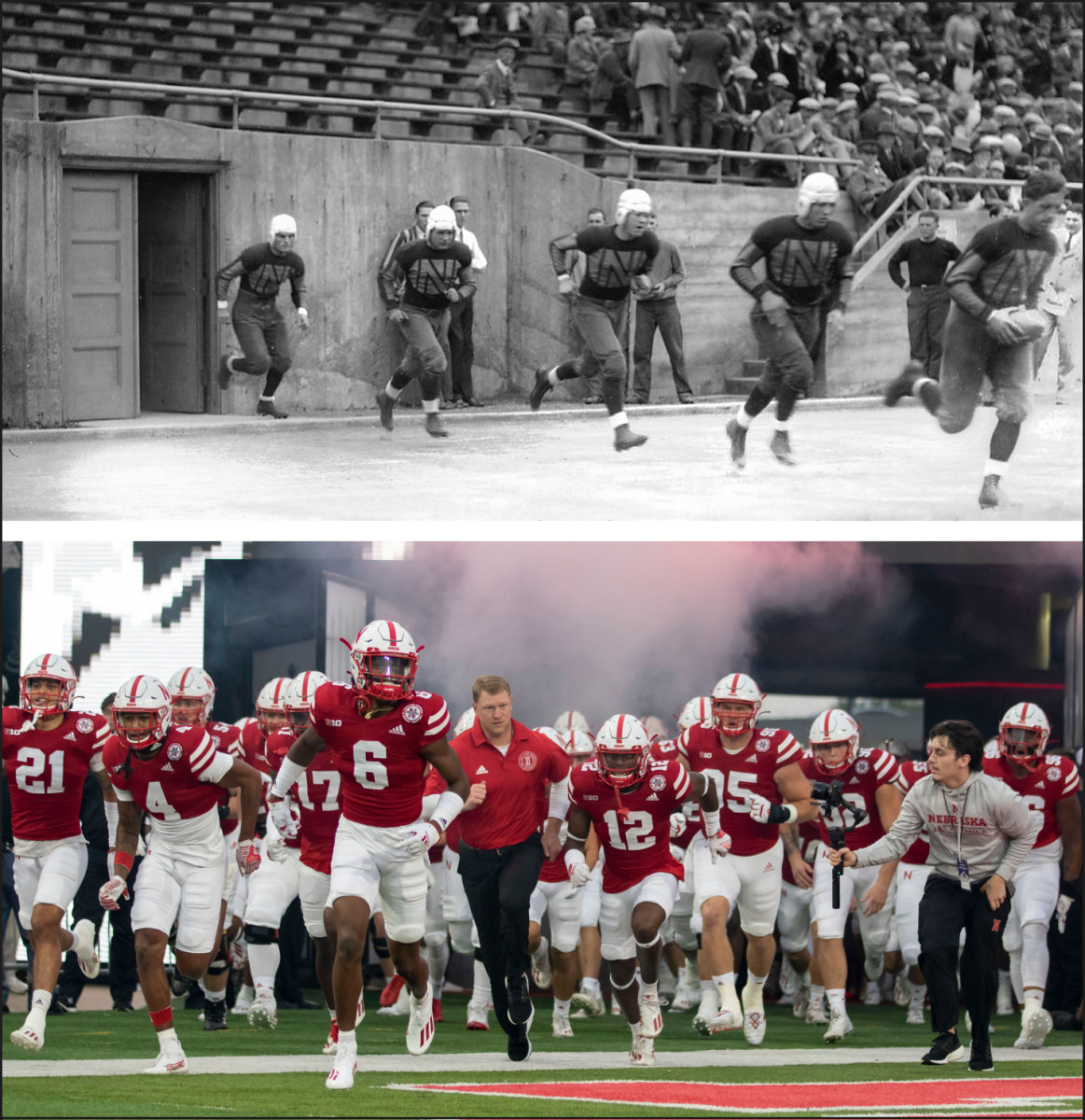
2006: North Stadium gets one of the nation's largest in-stadium replay screens and more than 6,500 new seats, including Skyline Suites and seating for the disabled. That brings stadium capacity to 81,067.
The Osborne Athletic Complex and Hawks Championship Center on the north end are completed. Nebraska's football offices, administrative offices and locker room move from South Stadium to North, and so does the Huskers' Tunnel Walk entrance. Shown above are 1927 and 2021 versions of the team's entry onto the field.
2009: All HuskerVision screens are upgraded to high-definition format. Two HuskerVision replay boards are added to the stadium along with electronic ribbon boards on the East and West Stadium façades.
2010: The Student Life Complex is added to the West Stadium. The trophy displays in North Stadium are expanded.
2011: Work begins on an East Stadium expansion. Approximately 6,000 seats will be added, along with an athletic research facility.
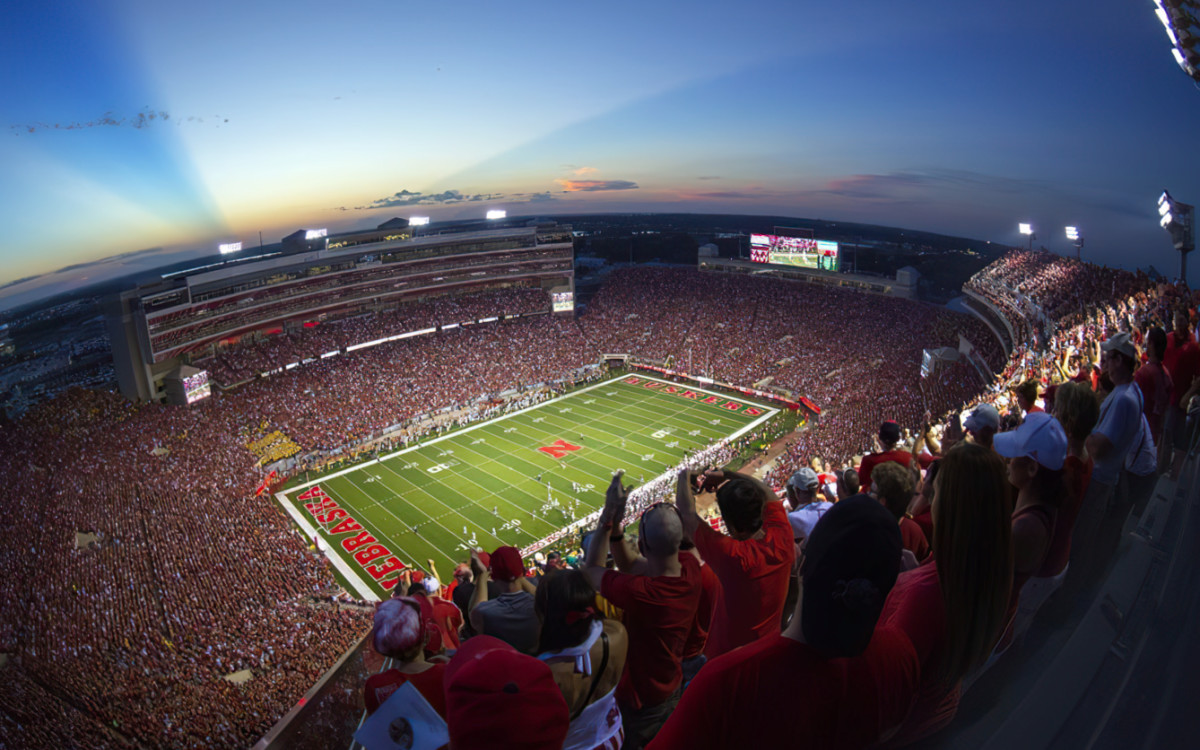
2013: The East Stadium expansion is completed, raising Memorial Stadium's capacity near 90,000. The FieldTurf playing surface is replaced. In the photo above, fans take in the view from East Stadium's new upper tier.
2014: The stadium's sound and WiFi systems are upgraded.
2017: All video screens are upgraded to 10mm. The North towers get wrap-around screens to give spectators in the north end zone a better view of replays. A ribbon board is added to the middle East Stadium balcony.
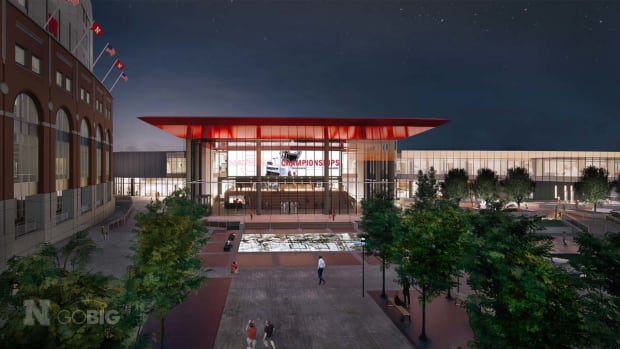
2021: Work begins on the $155 million, 350,000-square-foot North Expansion Project, which will include a new strength complex, locker room, football offices and training table.
2022: The FieldTurf playing surface is replaced.
What comes next? One change that appears imminent is fewer seats in exchange for more fanny room and more seatbacks. Restroom and concessions improvements are also on fans' wish lists, and keeping pace with technological advances will always be a work in progress.
But much bigger changes are possible as the Athletic Department digests the results of a recent fan survey. A complete redo of South Stadium has often been suggested.
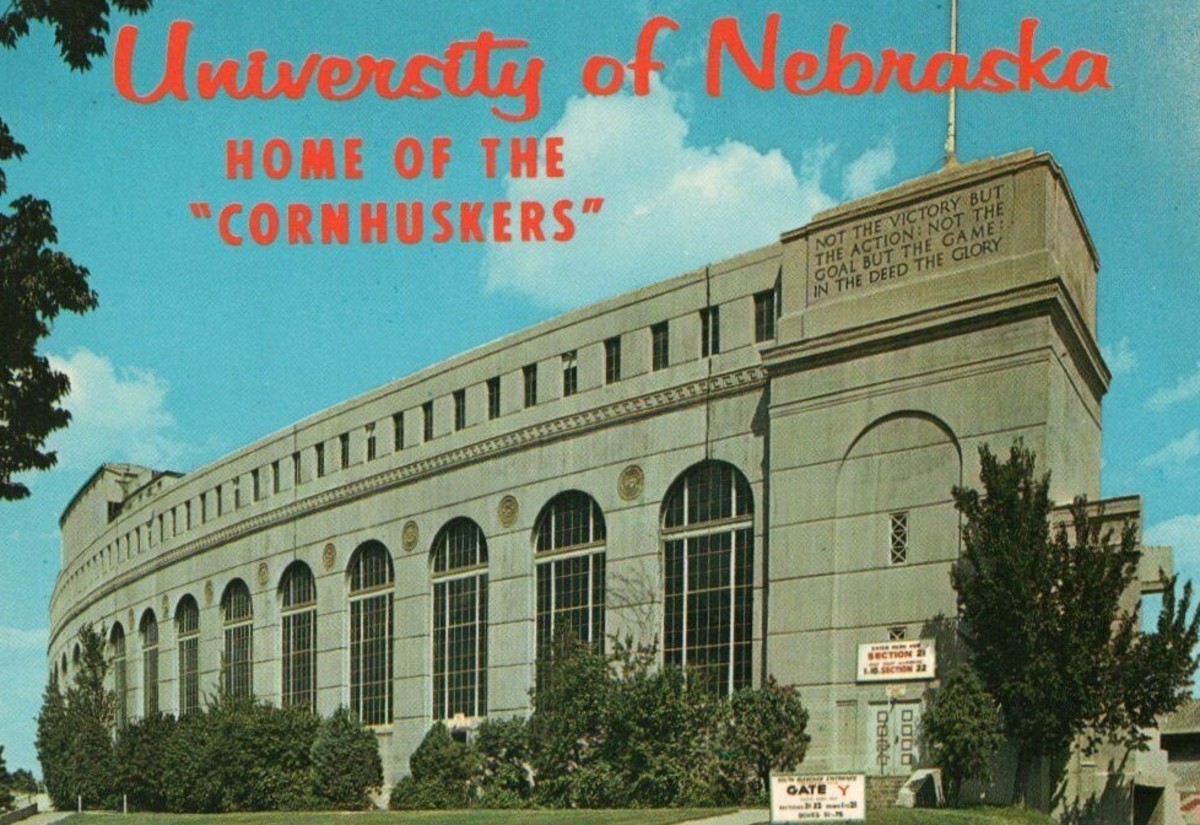
Through all the changes, the inscriptions on the four towers remain. Though no longer visible from outside the stadium, they serve as reminders of Memorial Stadium's century-old roots:
- Southeast: "In Commemoration of the men of Nebraska who served and fell in the Nations Wars."
- Southwest: "Not the victory but the action; Not the goal but the game; In the deed the glory."
- Northwest: "Courage; Generosity; Fairness; Honor; In these are the true awards of manly sport."
- Northeast: "Their Lives they held their countrys trust; They kept its faith; They died its heroes."
